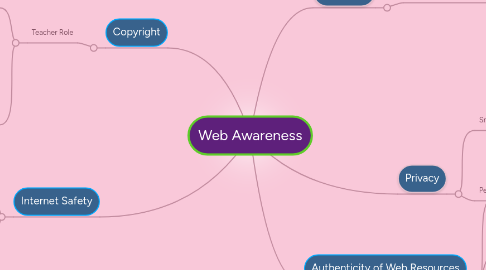
1. Copyright
1.1. Teacher Role
1.1.1. Copyright Laws
1.1.1.1. Intellectual Property
1.1.1.2. Copyright
1.1.1.3. Public Domain
1.1.1.4. Trademark
1.1.1.5. Genericized Trademark
1.1.1.6. Fair Dealing
1.1.1.7. Fair Use
1.1.2. Copyright and the Web
1.1.2.1. Cite sources
1.1.2.2. Give credit to author
1.1.2.3. Seek author's permission
2. Internet Safety
2.1. Web Awareness for Teachers
2.1.1. In Loco Parentis
2.1.2. Unhealthy sites
2.1.3. Easy to provide too much information
2.1.4. Marketing
2.2. Cyberbullying
2.2.1. Amanda Todd Example
2.2.2. Hate Websites
2.2.3. Fake Profiles
2.2.4. Use of Apps
2.3. Impact of Sexually Explicit Material
2.3.1. Interferes with healthy sexual development
2.3.2. Risk of Victimization
2.3.3. Changes expectations of relationships, physical appearance and behaviour
3. Authenticity of Web Resources
3.1. Fact or Folly
3.1.1. Fake Stories
3.1.2. Photoshopped Images
3.2. Email Validity
3.2.1. Who is the sender?
3.2.2. Where does the link take you?
3.2.3. Does it ask for personal information?
3.3. Critical Evaluation
3.3.1. Where does the information come from?
3.3.2. Who is the author?
3.3.3. How reliable is the source?
3.3.4. What biases exist?
4. Marketing
4.1. Kids are Multimillion Dollar Industry
4.1.1. Have purchasing power
4.1.2. Influence parents' buying decisions
4.1.3. Adult consumers of the future
4.1.4. Internet
4.1.4.1. Youth culture- daily and routine part of lives
4.1.4.2. Online without parental supervision
4.1.4.3. Unregulated
4.1.4.4. Easy to collect information for research
4.1.4.5. Engaging and interactive- build brand loyalties from young age
5. Privacy
5.1. Smartphone Pictures
5.1.1. Can be traced (location services)
5.2. Personal Publishing
5.2.1. Audience
5.2.2. Anonymity
5.2.3. Permanence
5.2.4. Copyright
5.2.5. Free Speech
